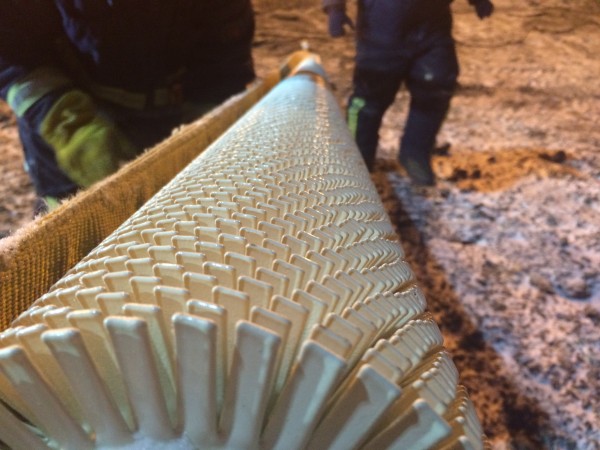Active or passive refrigeration
systems are typically used when a building located upon permafrost, must be in
contact with the ground, and insulation alone is not sufficient/cost effective
to prevent the heat flux from the building melting the permafrost below.
We typically recommend passive
refrigeration in areas where the system can provide sufficient cooling capacity
to maintain frozen ground beneath the structure during the summer months.
Generally we recommend thermosyphons for use in applications that require
passive cooling systems. Thermosyphons are gas-filled, sealed pipes that are
capable of transferring heat from a warmer location to a colder location.
Typically the thermosyphons are filled with pressurized carbon dioxide (CO2).
The pressure used in the thermosyphons defines the temperature at which the CO2
changes from a gas to a liquid. To maintain permafrost, the liquid CO2 needs to
boil and change to a gas at a temperature below the freezing temperature of
water. The CO2 gas will then revert to a liquid at a lower temperature. Within
a sealed thermosyphon, the gas will rise to the top of the thermosyphon, where
a radiator is located. When the ambient air temperature around the radiator is
low enough to remove the latent heat of the CO2 gas, it turns into a liquid and
flows back down the thermosyphon. The warmer soil temperatures then boil the
liquid CO2, absorbing heat from the ground. The CO2 gas then rises up to the
radiator, repeating the cycle. By installing thermosyphons under the footprint
of a structure, heat can be removed from the area, thus cooling the sub-grade
material.
Drill & Slurry pile foundations
have been the primary foundation construction method on Alaska’s North Slope
for the past 40 years. An oversized pilot hole is drilled at each pile location
and a smaller-diameter pile is either set on the bottom of the pilot hole or
suspended above the bottom of the pilot hole from above. The annulus of the
pilot hole is then filled with an aggregate-water mixture (a.k.a. sand slurry)
which ultimately freezes in-place to provide adfreeze strength to the pile
foundation.
For projects where a passive
refrigeration system cannot provide sufficient cooling capacity to maintain
frozen ground below the structure during the summer months, then we will
recommend either a combination of an active/passive refrigeration system or a
stand-alone active refrigeration system. Active refrigeration systems typically
consist of a refrigeration unit that circulates coolant under the building; they can be expensive to operate and that is why we try to combine them with a
passive system wherever possible.
We have designed refrigeration
systems for a range of projects, over an area from the North Slope down to
Bethel.


